No Railroad for Rideau: How and Why Rideau Missed Out on the Railway Boom
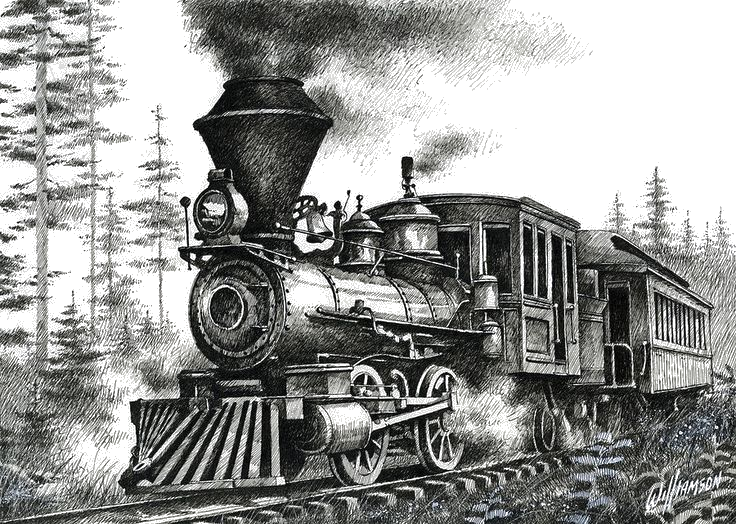
A Presentation by
Doug Matheson to RTHS
March, 2023

A transplanted westerner, since 1974 Doug Matheson has lived with his wife Barbara on River Rd. in Osgoode Township. A model railroader since he was old enough to say “train”, Doug has published numerous articles on the subject. He is also an amateur railway historian, and has recently published articles on the architects who worked for the CNR (and its predecessors) in creating a legacy with their railway station designs.
In his introduction, Doug acknowledged two individuals who have made important contributions to the understanding of railway history in eastern Ontario: Brian Gilhuley and Colin Churcher, whose historical maps and collections provide a clear visual and written record of the chronology of railway development. The maps in the Historical Background section below are courtesy of Brian Gilhuley. Doug also referred to Colin’s website: Colin Churcher’s Railway Pages, which contains an extensive collection of railway-related history, with a particular emphasis on eastern Ontario. Both Brian and Colin have their work accessible from the Craig Memorial Library at the City of Ottawa Archives.
Historical Background to Railway Building in Canada
Doug noted that in 1836 there were no communities of significant size in eastern Ontario, and certainly not in the area that would become Rideau Township (North Gower and Marlborough townships). The lack of practical roads or trails hampered settlement interior to the waterways, principally the Rideau River. It was acknowledged that means of transportation would have to expand and improve if settlement was to prosper. And while there was a general awareness of railway developments in Britain (over 2,000 km of railway by 1844) railway fever came a little later to British North America.
It was not until 1849, with the passage of the Railway Guarantee Act that railway building really got started in the Province of Canada. The “Act” stated that chartered railways longer than 75 miles (120 km) were eligible to receive a government grant that guaranteed interest of up to 6 per cent on half its bonds once half of the railway had been completed.
As communities came to believe that having a railway nearby was essential to ensuring long-term prosperity (and, conversely, that lack of a railway put your community at a disadvantage) interest in attracting railways increased. However, crises in the financial sector in Britain and beyond severely restricted the availability of investment money in the late 1840s. But when the Province of Canada introduced the Municipal Loan Fund (1852), enabling municipalities to borrow on the province’s credit to invest in “important works” (as it turned out almost exclusively railroads), railroad “fever” was unleashed.
A Chronology of Railways Built in Eastern Ontario
1854: Bytown & Prescott Railway (B&P) is constructed (more on this railway later)
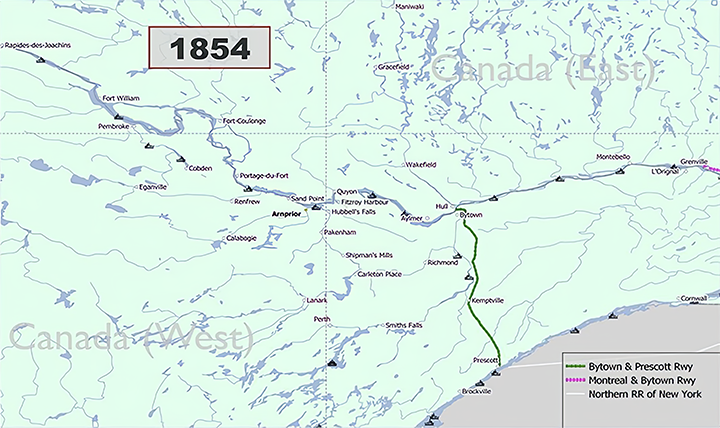
1856: Grand Trunk RR (GTR) is built from Montreal to Toronto and on to Sarnia, and eventually Chicago. This was to be the main carrier for almost 50 years in the absence of serious competition.
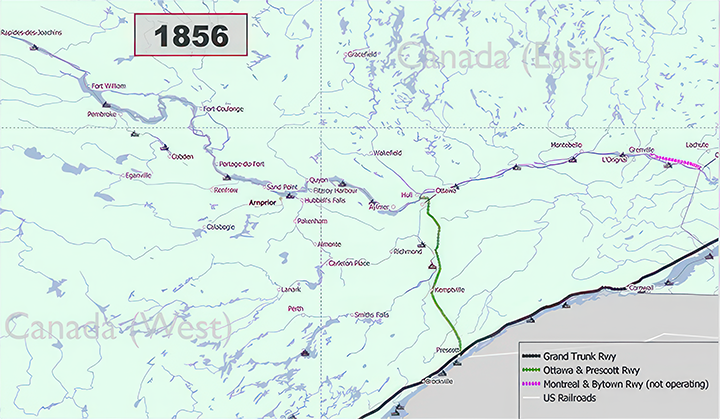
1859: The Brockville & Ottawa (B&O) RR is under construction. The constructed route is from Brockville to Smiths Falls (with a branch line to Perth) to Carleton Place and Almonte (more on this railway later).
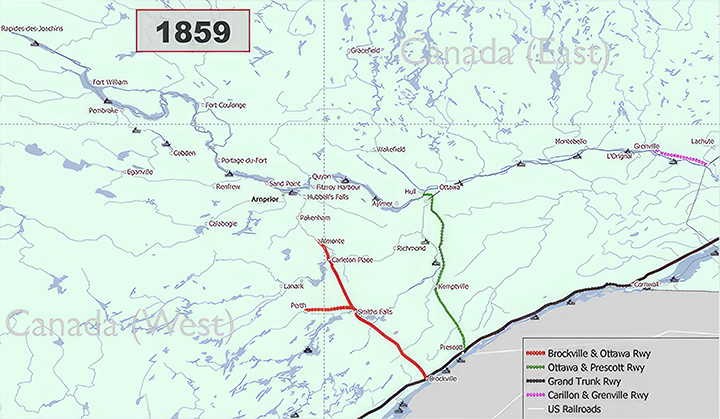
1865: The Brockville & Ottawa (B&O) RR reaches Sand Point, on the Ottawa River near Arnprior with a view to capturing trade (largely timber) in the Upper Ottawa Valley.
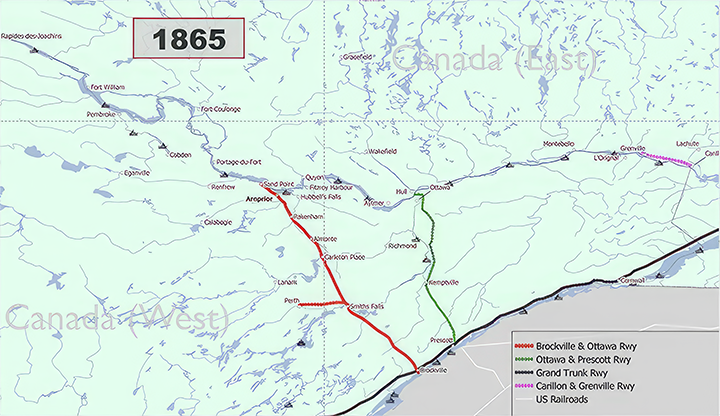
1870: The Canada Central (CC) RR builds from Ottawa to Carleton Place.
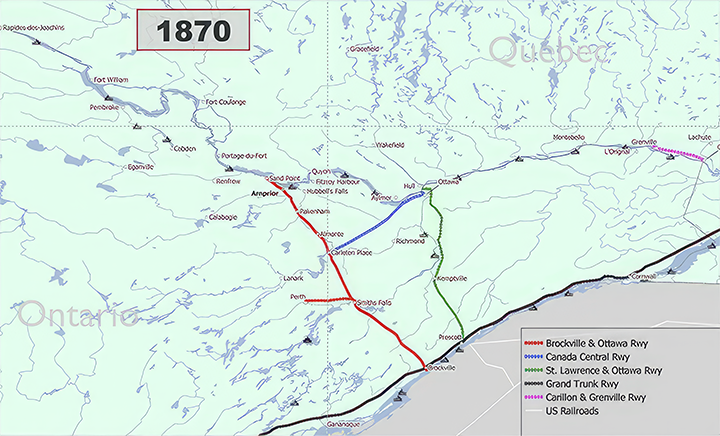
1872: Due to financial and management problems on the B&O, the CC assumes control of the Carletion Place to Sand Point portion of the B&O.
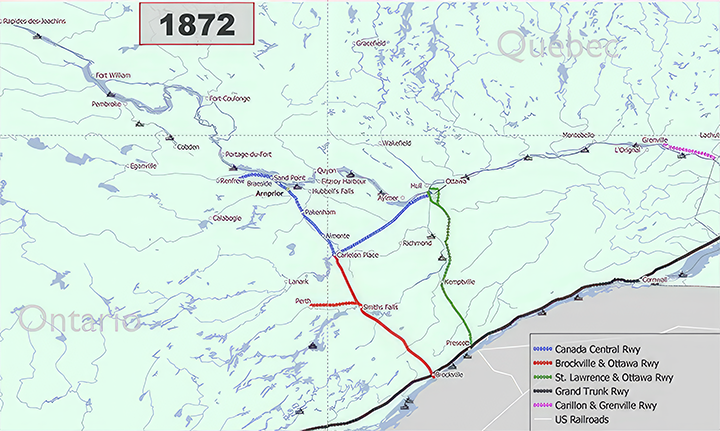
1876: The CC RR has built up the Ottawa Valley almost to Pembroke.
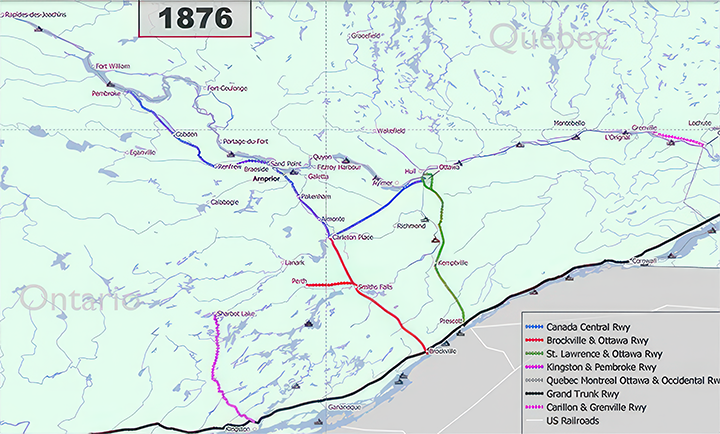
Note: Construction of the transcontinental Canadian Pacific (CPR) RR had begun in 1875, following delays precipitated by the Pacific Scandal that saw Sir Joh A MacDonald’s government removed over fraud charges related to the election of 1872. Although the principals of the Canada Central Railway were associated with the government, they were not “contaminated” by the fallout of the Pacific Scandal.
1880: The CC takes over the remainder of the B&O and extends further up the Ottawa Valley.
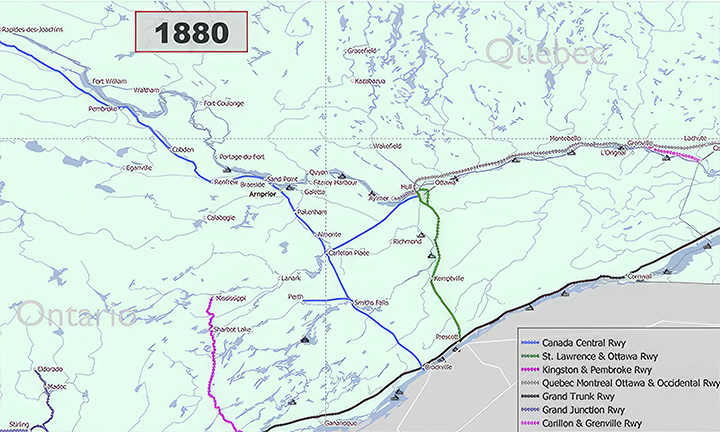
1884: The Canada Atlantic (CA) RR constructed from Ottawa to Coteau Landing on the St. Lawrence. The Canadian Pacific enters eastern Ontario in a big way. CP had followed the north shore of the Ottawa River to Ottawa. It then purchased the Canada Central and the Bytown & Prescott, which had been reorganized as the St. Lawrence & Ottawa RR. CP completes the transcontinental and runs its first trains from Vancouver to Montreal.
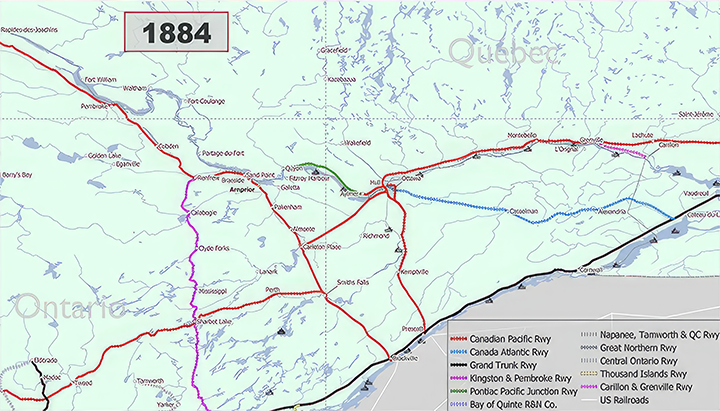
1890: The CPR has built a line from Montreal through Kemptville, Smiths Falls and Perth, and on to Toronto to compete with the GTR.
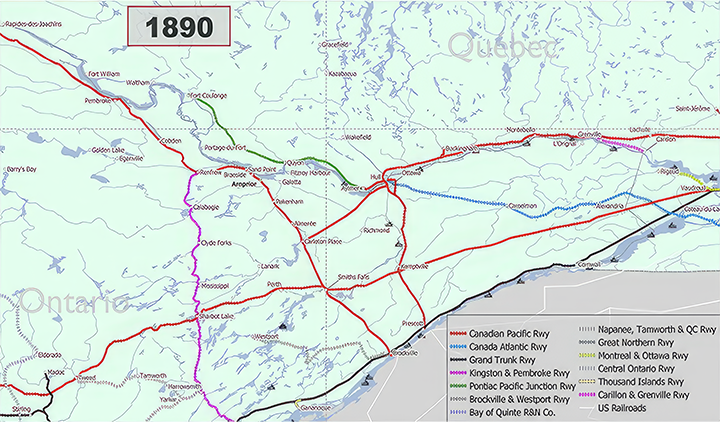
1893: J.R. Booth, who also owns the Canada Atlantic RR has completed his Ottawa, Arnprior & Parry Sound (OA&PS) RR through Arnprior as far as Eganville.
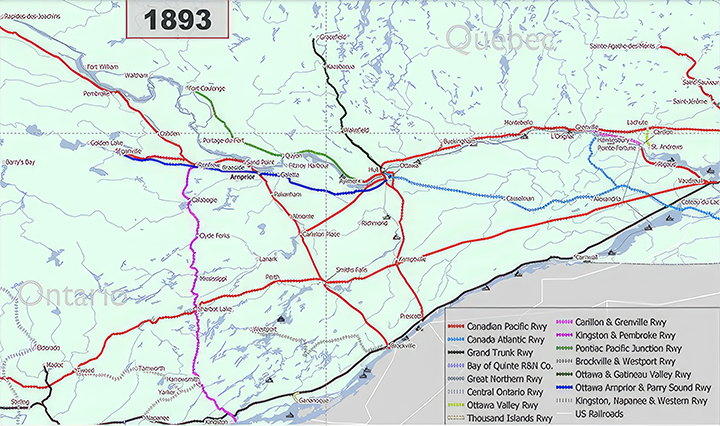
1896: The OA&PS reaches Parry Sound. The CA and OA&PS are consolidated.
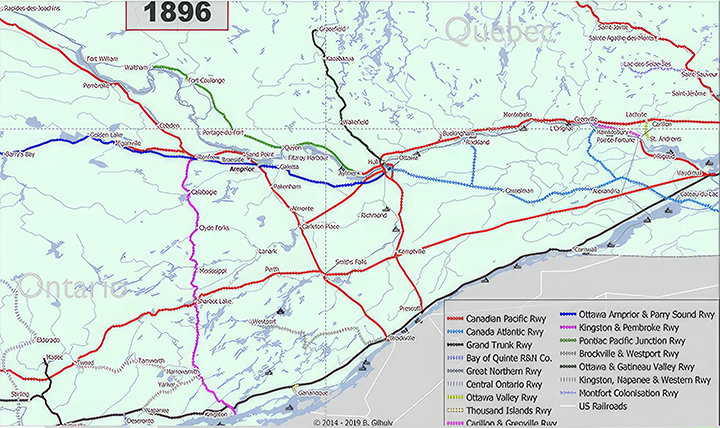
1900: The New York Central RR constructs the Ottawa & New York RR, with connections through Messina, NY to US markets.
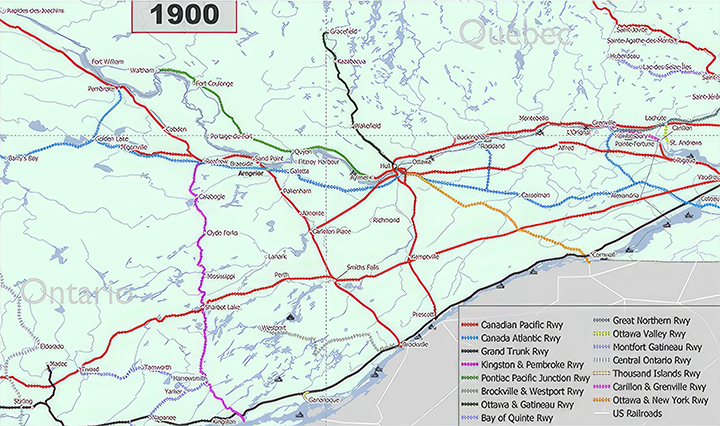
1905: The GTR buys the Canada Atlantic.
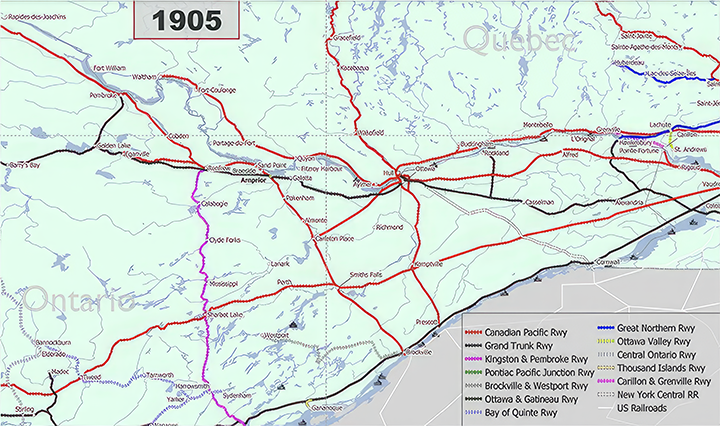
1910: The Canadian Northern Railway (CNoR) enters eastern Ontario by purchasing the Great Northern Railway, which had built from Montreal to Hawkesbury, and extending the line to Ottawa by 1916. The CNoR, which had transcontinental plans of its own had also bought up other smaller railroads in Ontario.
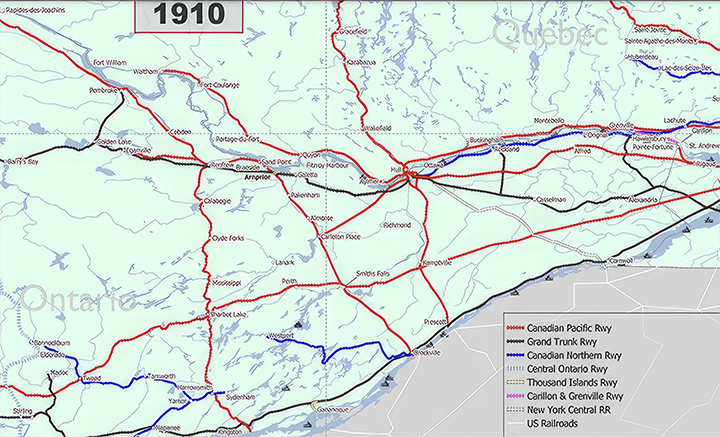
1916: The CNoR builds from Ottawa to Smiths Falls. This line does, in fact touch Marlborough Township near Dwyer Hill Rd., so while the claim of “NO” railroads in Rideau is not technically true, there was no station stop or other facilities built in this section.
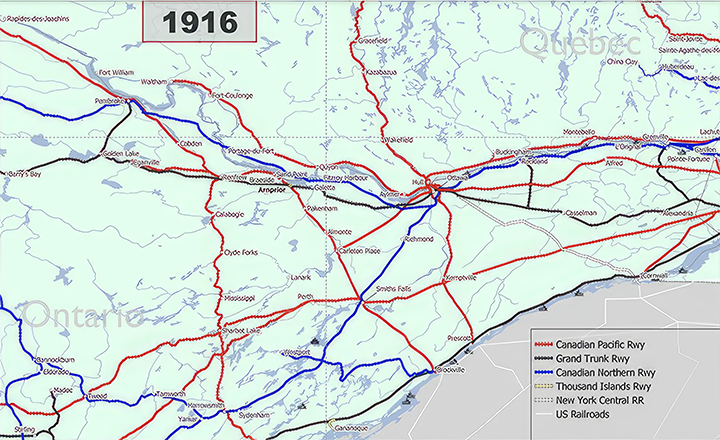
1923: Full consolidation of eastern Ontario railways with either the Canadian Pacific OR Canadian National, which assumes control of the bankrupt CNoR and GTR railways.
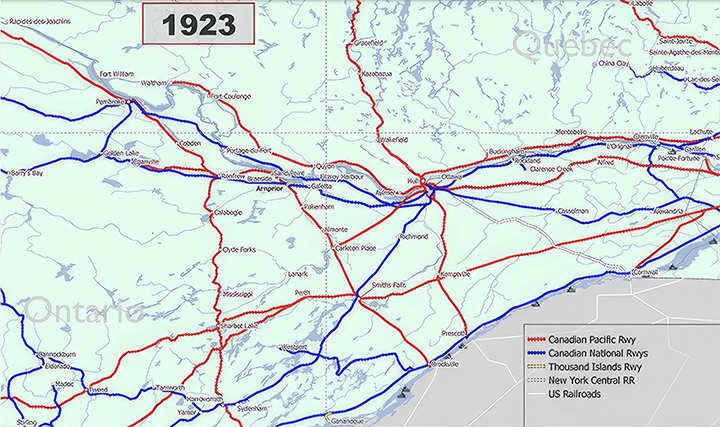
Eastern Ontario Railroads Chartered (Approved) But Not Built
Three railroads received government charters/approval to build; two of the three had specific plans to pass through Rideau Township.
Perth & Kemptville RR (Chartered 1852): Intended to connect Perth with a) Ottawa via a connection with the Bytown & Prescott RR near Kemptville; and b) either Belleville or Peterborough.
Brockville, Merrickville & Ottawa (Chartered 1885): Intended to connect Brockville with Ottawa via Merrickville. Line was to run through both Marlborough and North Gower townships.
Ottawa, Rideau Valley & Brockville (Chartered 1910): Intended to connect Brockville to Ottawa via Nepean, North Gower and Marlborough.
Generally, these lines were not built due to lack of funding, often arising from the narrow interests and/or small populations to be served by the proposed RR.
Why Not Rideau?
The avoidance of Rideau township by constructed railways was largely a function of geography. The larger railways were focused on connecting the major centres of Montreal, Toronto and Ottawa, and located their lines accordingly, generally forming a triangle linking the three centres. Rideau township is essentially in the middle of that triangle, and therefore not on the shortest routes to the triangle’s corners. Had there been a compelling business case for more direct north-south connections between Ottawa Valley and the St. Lawrence, building through Rideau may have been justified.
The North-South Railroads – a Closer Look
The Brockville and Ottawa RR: The businessmen of Brockville felt that if they could forge a railway connection with the Ottawa Valley west of Ottawa, Brockville could become a hub for distributing the productivity of the upper valley (largely logs & lumber), and for providing the goods needed for the prosperity of that region. The plan faltered when the lumber barons who held the cutting rights to the forests built their sawmills in Ottawa, combined with the financial and management problems mentioned earlier. Completed to Sand Point in 1870, by 1876 the Canada Central RR had purchased the section north of Carleton Place, and by 1880 the CC had the complete B&O line.
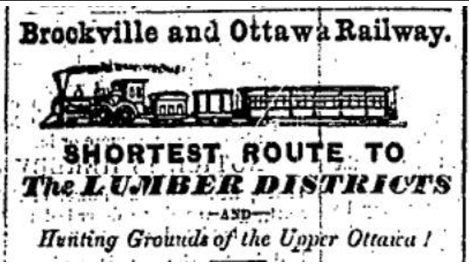
The Bytown & Prescott RR: The first railway in eastern Ontario, the road was promoted by business interests in both Ottawa and Prescott who felt the line could capture the sawed lumber trade (whole logs were most practically floated to Quebec City) intended for the US markets. The rails themselves were constructed to match the gauge of the US lines to facilitate interchange of rolling stock across the border.
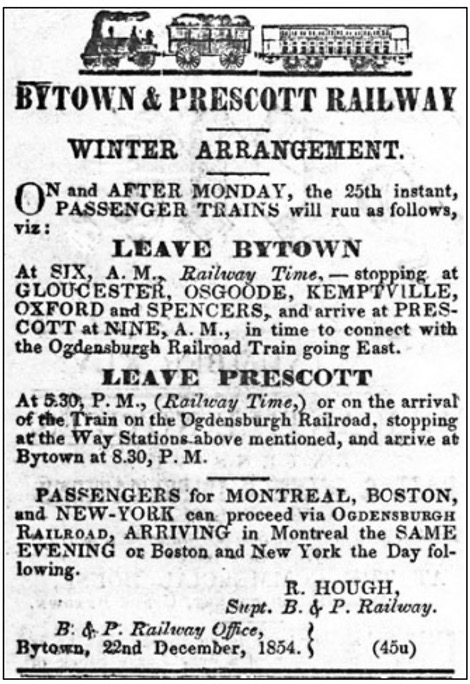
Enter a Villain – Walter Shanly
From the perspective of Rideau Township, Walter Shanly was the person who determined that the Bytown & Prescott RR should NOT pass through Marlborough and/or North Gower townships.
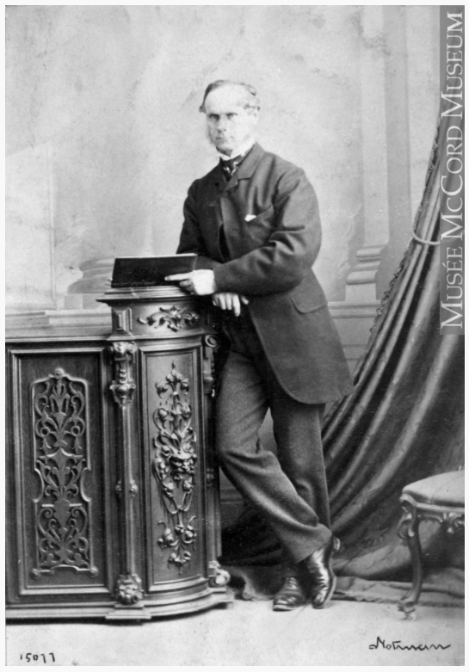
Born in Ireland and immigrating to Canada with his family in 1835, Walter Shanly left home at an early age. Working first as a surveyor on canal construction, he became an accomplished and respected – and self-taught – engineer. A man with a large ego and strong opinions who commanded respect rather than friendship, when Shanly was retained by the B&P RR he felt the company’s Directors should “conduct themselves with wholesome awe of me, and with becoming humility.” All this while demanding – and getting – an exorbitant sum for his services!
Shanly’s contract was to survey and recommend a route for the railway among four options, only one of which would have passed through Rideau township. Shanly ultimately chose what was known as the Middle or Direct route. His rationale against the western route (WR) centred on two points:
- The WR would put the northern terminus near the Chaudiere (Lebreton Flats) or the Parliament Hill cliffs. Shanly stated that the engineering challenges and construction costs of providing railroad facilities and a depot at the foot of Parliament Hill would prohibitive.
Interestingly, Shanly felt the terminus should be near the canal basin in Lowertown, even though the transport of lumber was expected to be the major businesses of the railroad, and the mills producing the lumber were located principally around Lebreton Flats! Other than the cost of building terminal facilities, the historical record sheds no further light on the reasons for Shanly’s recommendation.
- The WR would require a swing bridge across the Rideau Canal, creating both inconvenience to river traffic and substantial increased cost of construction and operational costs.
In his report to the Directors, Shanly stated that although he had given the other routes only a “cursory” examination, he was so certain of his recommendation, that no further consideration of alternate routes was necessary. The Directors apparently agreed, and the railway built into Bytown/Ottawa to the east of the Rideau River, crossed the Rideau via the Bytown and Prescott Railway bridge (the first bridge to cross the Rideau River.) The terminal depot and freight handling facilities were located on Sussex Avenue approximately where the Embassy of Japan sits today.
Consequences
By the 1860s the B&P RR was insolvent due to lack of traffic, and was foreclosed in 1865; in 1867 it was reorganized as the St. Lawrence & Ottawa RR.
In 1870, the Canada Central RR completed a line from Carleton Place to Lebreton Flats, which had become the industrial heart of Ottawa. In an effort to keep up, the St. Lawrence and Ottawa RR completed a spur line to the Chaudiere from their main line at Ellwood Station (near the current LCBO warehouse on Bank St.). It crossed the Rideau River via a new bridge built on the current lands of Carleton University, and crossed the canal via swing bridge at Dow’s Lake. The route adjustment to the St. Lawrence & Ottawa RR occurred just 20 years after Walter Shanly recommended against such a route into Ottawa.
Hindsight
In hindsight, it may have been a better choice to adopt the western route for the Bytown & Prescott, crossing the Rideau River at or near Kemptville (eg. Beckett’s Landing). Doing so would have likely have had significant impact on the development history of Rideau Township in late 1800s and early 1900s.
Report by Rod Brazier
